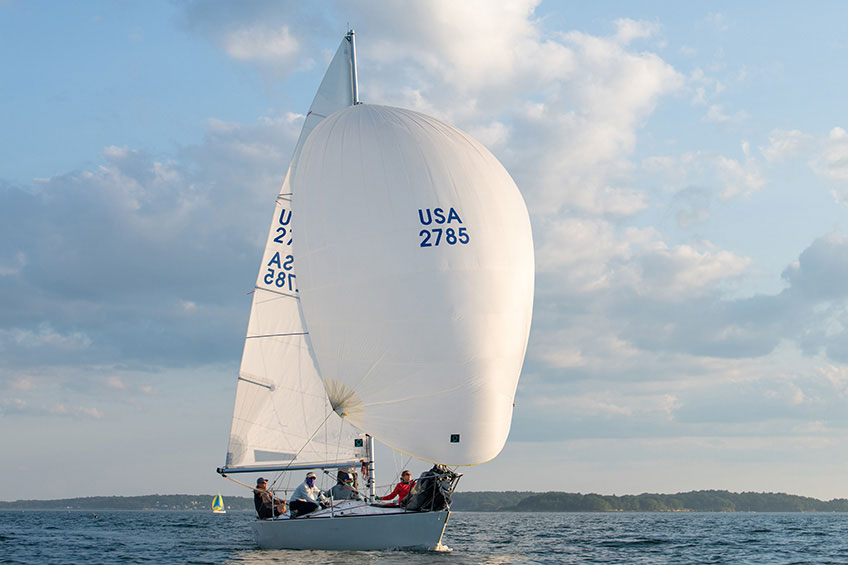Quantum Portland's Carter White details his goal setting process and gives some pointers for tackling the challenging J/24 regatta schedule in store for 2022.

Sailboat racing often takes years to master. And in the pursuit of that mastery, many of us have been racing J/24s for over 40 years. But time in the boat doesn’t necessarily result in better performance. Most of us are weekend warriors and vacationers who show up at a few regattas a year and race on weeknights at our local clubs. The idea of finding a team to commit to more than a few practice days and then hiring a coach can be both time-consuming and costly. I propose another option: be your own coach.
In order to coach yourself for this year’s major J/24 events, you’ll need to focus on mastering a variety of challenging conditions. Worlds will be in Corpus Christi, TX, where competitors can expect choppy and windy racing. US Nationals will be in Dallas, TX, on a lake where the conditions are typically shifty with flat water. The European Championship will be in Howth, Ireland, where competitors can expect ocean sailing conditions: winds of 12 to 15 knots each day in deep water with big rollers and very few obstructions. There are other regatta venues with strong current and tricky geographic shifts. Add to all of this the potential for major weather fronts that can totally change the typical conditions for each venue.
In addition to studying up on forecasts and typical conditions, refining your skills and setting goals for your team will prepare you for the challenges ahead in the 2022 J/24 season. In order to set goals and work towards them, you’ll have to learn to be your own best coach. Here are some tips to help you get started.
First, write down your goals. Not writing down a goal makes it just a dream, and dreams rarely come true without solid effort and execution. When I write down my sailing goals, I think of them in three tiers. The top tier is the big picture: “I want the experience to be fun on and off the water and to build a solid team that buys into our goals.” The second tier is more results oriented: “We want to place in the top 15 at the Worlds or we want to win our local weeknight series.” The third-tier goal is actionable and focuses on improving skills: “We want to improve our starting technique and downwind speed.”
Next, write down the specific action items that it will take to achieve your goals. By tying the action items to the goals, you give these “chores” purpose, which will help you execute with more intention and result in better follow-through and results. For example, my most important action item related to my tier-one goal is to improve communication among the crew. As my own coach, I think about how and when I communicate and what makes communication most effective. Poor communication is one of the biggest weaknesses I see in many programs.
Other examples of action items include arriving to a race 15 minutes earlier each morning to tune the boat more accurately or checking several weather websites in advance to give you a leg up on the forecast and conditions. Preparation can also help you update equipment or perform maintenance like buying new sails, fairing the keel, measuring the rig, and replacing lines on the boat. Getting into this routine will ensure you have more consistent success on the racecourse.
Finally, the action items connected to improving your skills need to be specific and easy to follow through on. For example, if your goal is to improve your starting technique, research the drills you can do quickly and easily each time you’re on the water. They may include time and distance drills that can be done with a buoy in the water. Or you can use that same spot to practice a port tack approach where the buoy represents a starboard boat you need to tack under and get as close to as possible. Or you can use that same buoy to practice keeping your boat in one place as long as possible without losing flow on the keel. This helps with accelerating off the line. For each skill, there are drills you can do that don’t require much time or equipment and can be practiced easily whenever you’re on the water.
And don’t forget to tie your goals back to the tricky venues. A choppy venue may suggest you work on driving and trimming in waves. For shifty lake venues, practice spotting those puffs on the water and communicating them with the rest of the team on the boat. In a venue with particularly strong tides or currents, equip yourself with time and distance drills and do some serious research on how the water moves through the area.
Once you’ve got your goals in place, chat with a sail consultant for some drill recommendations. They can be a great resource to help you complete the loop of goal setting, practicing, and finally taking what you learned into a regatta. Many of Quantum’s sail consultants have backgrounds in coaching, so pick our brains about goal setting. We’re always excited to help take a program to the next level, whatever that may look like for you and your team. Get in touch with Carter White or another J/24 Class expert to talk about goal setting and all things J/24.